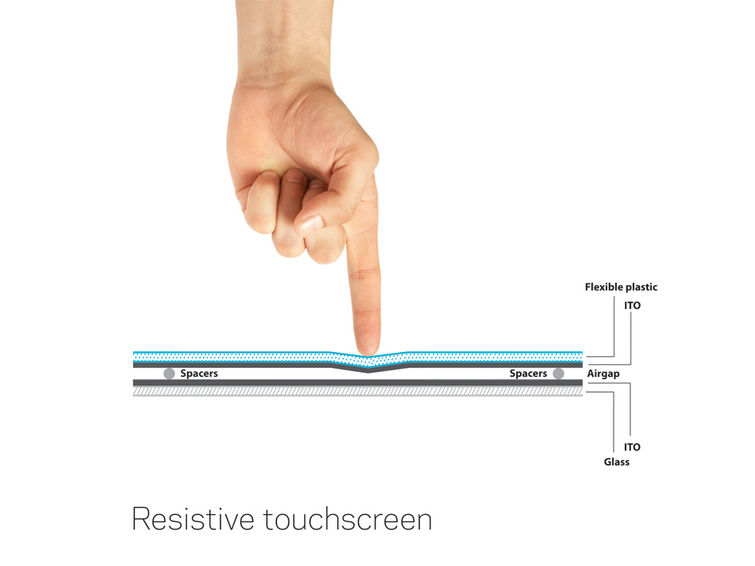 |
In Resistive touch screen,
The front surface is made of scratch-resistant, flexible plastic with a thin film of conductive material (usually Indium Tin Oxide or ITO) printed onto its underside. Beneath it is a second layer – usually made of glass, but sometimes of hard plastic – also with a coating of ITO.
The two layers are kept apart by tiny bumps or spacers placed at regular intervals, and the thin layers of ITO create an appreciable electrical resistance – the sandwich is so constructed that electrical charge runs from top to bottom on one layer but side-to-side on the other layer.
When the screen is touched the plastic deforms so that the two ITO films meet, and by measuring the resistance of both layers at their point of contact it’s possible to get an accurate measurement of the touch position. This, of course, relies on an even coating of ITO on the layers, plus accurate calibration: with some early touchscreen mobiles, the calibration could drift as the battery became depleted, but nowadays, unless you buy a fake phone, you shouldn’t experience this problem.
Most older phones use resistive screens, but that isn’t to say it’s an out-of-date technology, as phones are still being churned out using this type of screen (a good clue is normally, although not always, that the device is supplied with a stylus). Most people probably first encounter resistive screens in Windows Mobile devices (apart from the HTC HD2).
And in capacitive touchscreen,
There are two types of capacitive touchscreen generally available, surface and projected, and it’s the latter that you’ll find in smartphones. These again consist of a sandwich, but this time of two spaced layers of glass, again coated with ITO on the inside.
Depending on the particular screen, the ITO layer may be a uniform coat,
a grid, or parallel stripes running at right angles on the two sheets.
The latter scheme is used in the iPhone and the iPod Touch Duplo, better
known as the iPad.
Think back to O Level physics, and you might remember that a
capacitor consists of two plates separated by an insulating material,
which may of course be air. Now picture those perpendicular stripes on
two glass plates – wherever a stripe crosses one below it forms a
capacitor so small it’s measured in femtofarads (10-15F).
This small size is both bad news and good, because such a tiny capacitance is difficult to measure and requires complex filtering to eliminate noise; good, because given such a small capacitance it isn’t just the gap between the “plates” that affects the capacitance but also the space around them.
As your finger comes close to a capacitor it changes the local electrostatic field, and the system constantly monitors each tiny capacitor to discover exactly where the finger touched the screen: because the measurement points are discrete, it’s possible to tell whether several fingers are all touching the screen at once, unlike with a resistive unit.
This small size is both bad news and good, because such a tiny capacitance is difficult to measure and requires complex filtering to eliminate noise; good, because given such a small capacitance it isn’t just the gap between the “plates” that affects the capacitance but also the space around them.
As your finger comes close to a capacitor it changes the local electrostatic field, and the system constantly monitors each tiny capacitor to discover exactly where the finger touched the screen: because the measurement points are discrete, it’s possible to tell whether several fingers are all touching the screen at once, unlike with a resistive unit.
Credit : http://www.pcpro.co.uk






No comments:
Post a Comment